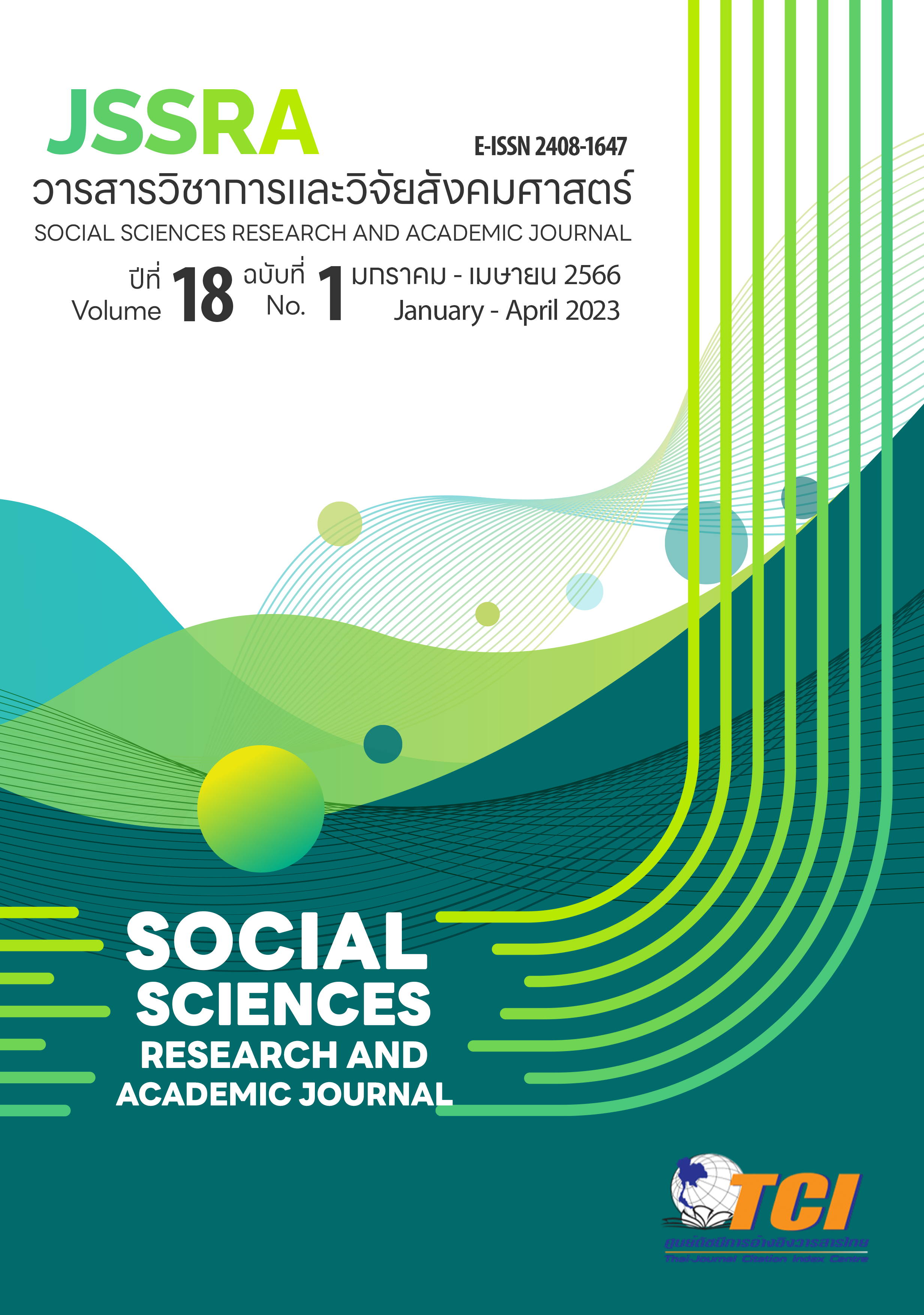รูปแบบการใช้นวัตกรรมในการจัดการเรียนการสอนในยุค Next Normal ของสถานศึกษาสังกัดสำนักงานเขตพื้นที่การศึกษาประถมศึกษา จังหวัดลพบุรี Model of Innovations Using into the Teaching and Learning in the Next Normal Era of Schools under the Lop Buri Primary Educational Service Area Office
Main Article Content
Abstract
This research aims to 1) investigate the innovations used in teaching and learning in the Next Normal Era of schools under the jurisdiction of the Lop Buri Primary Educational Service Area Office and 2) develop a model of innovations used in teaching and learning in the Next Normal Era of schools. Using the Yamane technique for stratified random sampling, 357 school administrators and teachers comprised the sample for this study. With a reliability of 0.91, the research instruments consisted of a questionnaire and a structured interview form. The data was analyzed statistically using percentage, mean, standard deviation, and content analysis.
The findings showed that: 1) The innovations incorporated into teaching and learning in the Next Normal Era were rated highly overall. In descending order of their mean values, they were arranged as follows: teaching with innovation, school contextual analysis, and evaluation of innovation use. 2) The innovation model for teaching and learning in the Next Normal Era included 1) the CIPP Model assessment 2) the innovations using into the teaching and learning 3) the key factors in the process 4) the outcome of the process and 5) the PDCA cycle that was feasible, useful, consistent, and appropriate for the context, as confirmed by the focus group discussion participants.
Article Details
References
เก็จกนก เอื้อวงศ์, ชูชาติ พ่วงสมจิตร์ และคณะ. (2564). รูปแบบการจัดการเรียนรู้สำหรับนักเรียนระดับการศึกษาขั้นพื้นฐานที่ได้รับผลกระทบจากสถานการณ์โควิด -19. รายงานการศึกษา, สำนักงานเลขาธิการสภาการศึกษา.
ณิรดา เวชญาลักษณ์. (2561). หลักการจัดการเรียนรู้. (พิมพ์ครั้งที่ 2). สำนักพิมพ์แห่งจุฬาลงกรณ์มหาวิทยาลัย.
ถนัดกิจ จันกิเสน. (2563). The Next Normal! 10 เทรนด์สังคมไทย ที่จะเกิดขึ้นหลังพ้นวิกฤตโควิด 19. The Standard. สืบค้นเมื่อ 22 เมษายน 2563, จาก https://thestandard.co/the-next-normal-10-trends-that-will-happen-after-coronavirus/
ธงชัย สมบูรณ์. (2563). The Next Normal ภูมิคุ้มกันของสังคมไทยในอนาคต. มติชนออนไลน์. สืบค้นเมื่อ 9 พฤษภาคม 2563, จาก https://www.matichon.co.th/article/news_2175208
ธิดารัตน์ เห็นพร้อม. (2563). โลกหลังวิกฤติ Covid-19 (ตอนที่ 6). บทความจากหนังสือพิมพ์รายวันทันหุ้น ฉบับออนไลน์. สืบค้นเมื่อ 28 พฤษภาคม 2563, จาก https://www.thunhoon.com/article/223485
พงศ์ทัศ วนิชานันท์. (2563). เปิดหรือปิดโรงเรียนอย่างไรให้ได้มากกว่าเสีย. กรุงเทพธุรกิจ, สถาบันวิจัยเพื่อการพัฒนาประเทศไทย (ทีดีอาร์ไอ). สืบค้นเมื่อ 6 พฤษภาคม 2563, จาก https://www.bangkokbiznews.com/blogs/columnist/125044
ภูมิศรัณย์ ทองเลี่ยมนาค. (2563). ผลกระทบของ COVID-19 ต่อระบบการศึกษาของโลกและประเทศไทยในมุมมองทางเศรษฐศาสตร์. สืบค้นเมื่อ 15 เมษายน 2563, จาก https://thaipublica.org/2020/04/19-economists-with-covid-19-15/
มารุต พัฒผล. (2562). การแก้ปัญหาเชิงนวัตกรรม. ศูนย์ผู้นำนวัตกรรมหลักสูตรและการเรียนรู้ (LCCL). http://www.curriculumandlearning.com/?page=Books&language=th
วัชรพล วิบูลยศริน. (2557). นวัตกรรมและสื่อการเรียนการสอนภาษาไทย. (พิมพ์ครั้งที่ 2). สำนักพิมพ์แห่งจุฬาลงกรณ์มหาวิทยาลัย.
วิชัย วงษ์ใหญ่ และมารุต พัฒผล. (2563). จากการเรียนรู้ออนไลน์สู่การสร้างสรรค์นวัตกรรม. ศูนย์ผู้นำนวัตกรรมหลักสูตรและการเรียนรู้ (LCCL). http://www.curriculumandlearning.com/?page=Books&language=th
วิชัย วงษ์ใหญ่. (2563). การออกแบบการเรียนรู้ใน New normal. ศูนย์ผู้นำนวัตกรรมหลักสูตรและการเรียนรู้ (LCCL). http://www.curriculumandlearning.com/?page=Books&language=th
สำนักงานคณะกรรมการการศึกษาขั้นพื้นฐาน. (2564). ระบบสารสนเทศเพื่อการบริหาร. กลุ่มสารสนเทศ, สำนักนโยบายและแผนการศึกษาขั้นพื้นฐาน. http://data.bopp-obec.info/
อัจศรา ประเสริฐสิน, เทพสุดา จิวตระกูล, และ จอย ทองกล่อมศรี. (2560). การศึกษาแนวทางการจัดการนวัตกรรมทางการศึกษาไปใช้ในการพัฒนาการเรียนการสอนและการทำวิจัยของครู. วารสารบรรณศาสตร์ มศว, 10(2), 78-89.
Cahapay, M. B. (2020). Rethinking Education in the New Normal Post-COVID-19 Era: A Curriculum Studies Perspective. Aquademia, 4(2), 1-5. Retrieved June 1, 2020, from https://doi.org/10.29333/aquademia/8315
Flannery, M. E. (2020). How teachers are integrating COVID-19 crisis into their lessons. NEA Today. Retrieved May 22, 2020, from http://neatoday.org/2020/04/22/teaching-about-coronavirus/
Olivier, W. (2020). Education post-COVID-19: Customised blended learning is urgently needed. The Conversation. Retrieved May 24, 2020, from https://theconversation.com/education-post-covid-19-customised-blended-learning-is-urgently-needed-138647
Patrinos, H. A., & Shmis, T. (2020). Can technology help mitigate the impact of COVID-19 on education systems in Europe and Central Asia?. Retrieved March 23, 2020, from https://blogs.worldbank.org/europeandcentralasia/can-technology-help-mitigate-impact-covid-19-education-systems-europe-and
Williamson, B. (2020). New pandemic edtech power networks. Code acts in education. Retrieved April 1, 2020, from https://codeactsineducation.wordpress.com/2020/04/01/new-pandemic-edtech-power-networks/


